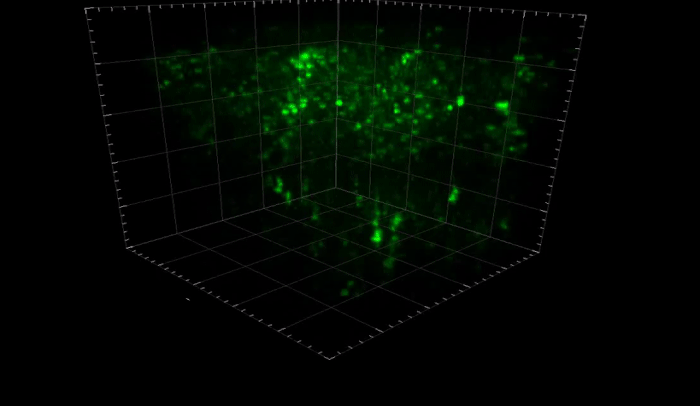
11th November 2016 Mouse neurons seen firing in real-time in 3-D Scientists at Rockefeller University have used a technique called "light sculpting" to see the neurons of a mouse brain firing in real-time in 3-D.
No single neuron produces a thought or a behaviour – anything the brain accomplishes is a vast collaborative effort between cells. When at work, neurons talk rapidly to each other, forming networks as they communicate. Researchers at Rockefeller University in New York are developing technology that would make it possible to record brain activity as it plays out across these networks. In research published by Nature Methods, they recorded the activity of mouse neurons layered in 3-D sections of brain as they signalled to each other in real time. "The ultimate goal of our work is to investigate how large numbers of interconnected neurons throughout the brain interact in real time and how their dynamics lead to behaviour," says Alipasha Vaziri, Ph.D., head of the Laboratory of Neurotechnology and Biophysics. "By developing a new method based on 'light sculpting' and using it to capture the activity of the majority of the neurons within a large portion of the cortex, a layered brain structure involved amongst others in higher brain function, we have taken a significant step in this direction." This type of recording presents a considerable technical challenge because it requires tools capable of capturing short-lived events within individual cells, all while observing large volumes of brain tissue. Vaziri began working toward this goal about six years ago. His group first succeeded in developing a light-microscope–based approach to observing the activity in a 302-neuron roundworm brain, before moving on to the 100,000-neuron larval zebrafish. Their next target was the mouse brain, which is more challenging for two reasons: not only is it more complex, with 70 million neurons, but the rodent brain is also opaque, unlike the more transparent worm and larval fish brains. To make the activity of neurons visible, they had to be altered. The researchers engineered the mice so their neurons could emit fluorescent light when they signalled to one another. The stronger the signal, the brighter the cells would shine. The system they developed had to meet competing demands – it needed to generate a spherically-shaped area, slightly smaller than the neurons and capable of exciting fluorescence from them. Meanwhile, it also had to move quickly enough to scan thousands of these cells in three dimensions as they fired in real time. The team accomplished this using a technique called "light sculpting," in which short pulses of laser light – each lasting only a quadrillionth of a second – are dispersed into their coloured components. These are then brought back together to generate the "sculpted" excitation sphere. This sphere is scanned to illuminate the neurons within a plane, then refocused on another layer of neurons above or below, allowing neural signals to be recorded in three dimensions. In this way, Vaziri and his colleagues recorded the activity in one-eighth of a cubic millimetre of the animal's brain cortex, a volume that represents the majority of a unit known as a cortical column. By simultaneously capturing and analysing the dynamic activity of the neurons within a cortical column, researchers think they might be able to understand brain computation as a whole. In this case, the section of cortex they studied is responsible for planning movement. They are currently working to capture the activity of an entire such unit. "Progress in neuroscience, and many other areas of biology, is limited by the available tools," Vaziri says. "By developing increasingly faster, higher-resolution imaging techniques, we hope to be able to push the study of the brain into new frontiers." ---
Comments »
|







